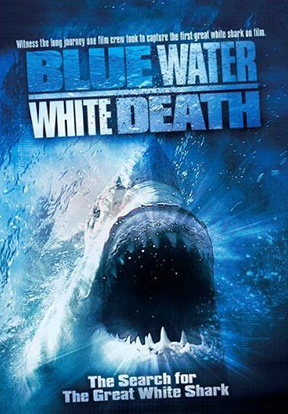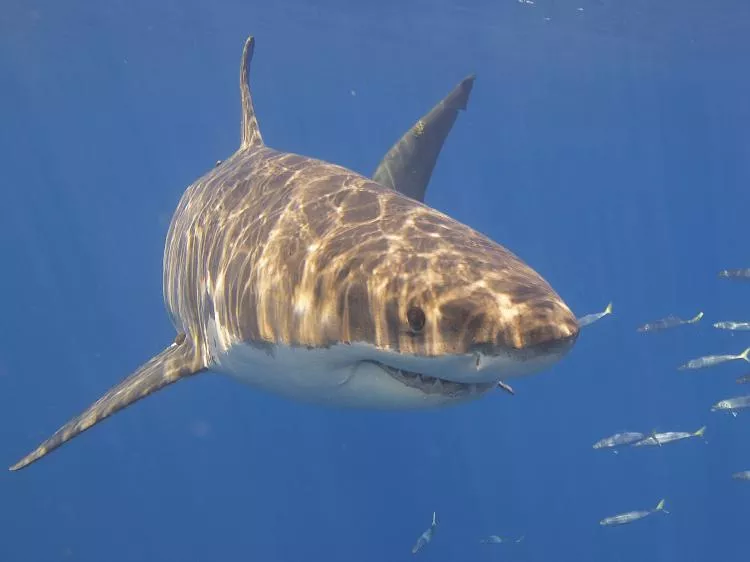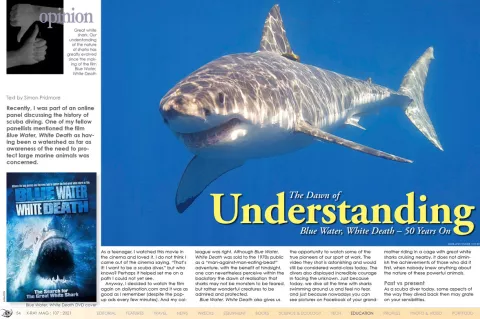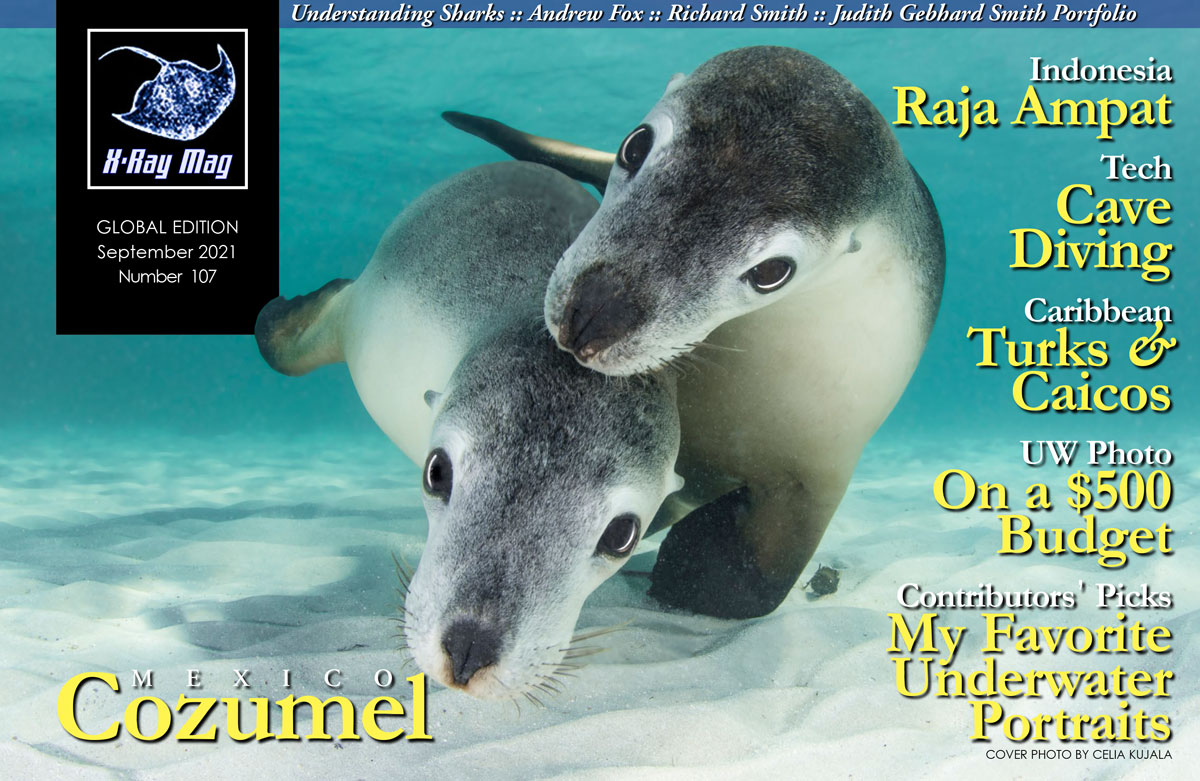Recently, I was part of an online panel discussing the history of scuba diving. One of my fellow panellists mentioned the film Blue Water, White Death as having been a watershed as far as awareness of the need to protect large marine animals was concerned.
Contributed by
As a teenager, I watched this movie in the cinema and loved it. I do not think I came out of the cinema saying, “That’s it! I want to be a scuba diver,” but who knows? Perhaps it helped set me on a path I could not yet see.
Anyway, I decided to watch the film again on dailymotion.com and it was as good as I remember (despite the pop-up ads every few minutes). And my colleague was right. Although Blue Water, White Death was sold to the 1970s public as a “man-against-man-eating-beast” adventure, with the benefit of hindsight, one can nevertheless perceive within the backstory the dawn of realisation that sharks may not be monsters to be feared, but rather wonderful creatures to be admired and protected.
Blue Water, White Death also gives us the opportunity to watch some of the true pioneers of our sport at work. The video they shot is astonishing and would still be considered world-class today. The divers also displayed incredible courage in facing the unknown. Just because today, we dive all the time with sharks swimming around us and feel no fear, and just because nowadays you can see pictures on Facebook of your grandmother riding in a cage with great white sharks cruising nearby, it does not diminish the achievements of those who did it first, when nobody knew anything about the nature of these powerful animals.
Past vs present
As a scuba diver today, some aspects of the way they dived back then may grate on your sensibilities.
In the late ‘60s and early ‘70s:
- Divers used to go into the water tooled up and ready for a fight, like Star Trek’s Captain Kirk and company landing on an alien planet.
- The primary way in which they would interact with big fish at that time was to wave recently killed smaller fish around to try to make the big fish do something interesting.
- When you dived, you swam; you did not float. With no means to adjust your buoyancy, your fins were what kept you from sinking. So, you never stopped flapping.
But I would urge you to look past these things. That was then; those were different times.
The movie

Blue Water, White Death follows the adventures of a hand-picked team of top divers travelling the world looking for great white sharks. They do not find any until a few minutes before the end of the movie, when they encounter them in cooler waters off Australia, close to beaches where there are colonies of seals.
The footage was filmed in 1969 and the movie was released in 1971. The producer and director was Peter Gimbel, a New York department store heir, whose association with the sunken liner Andrea Doria made him famous in the United States. He was the first to dive and photograph the shipwreck and went on to produce two documentaries, one of which centred around the opening of the captain’s safe, live on national television. The dive team in Blue Water, White Death includes American photographer Stan Waterman and Australian spearfishing champions and filmmakers Valerie and Ron Taylor.
The story line
The film begins with the team arriving in South Africa. They charter a boat and head out for the whaling grounds, where big sharks are said to follow the fleet. Their idea is to find a whaler that has just made a kill and has fed compressed air into the carcass to make it float. The divers will then ask permission to film around the dead whale, hoping for shark action.
Which is what happens. The footage of the harpooning of a sperm whale is horrific and shocks the team. After showing the whaler’s bow cannon shoot the whale three times before it dies, the camera flicks to Valerie Taylor with her hand to her mouth, screaming, “They shot him! They shot him!”
Then it cuts to Waterman, filmed up close, looking out to sea, saying: “Such extraordinary creatures, marvellously intelligent. At the rate they are being hunted now, they’ll be extinct before we really come to understand them.”
It is unlikely that many of the film-going public in 1971 had ever seen how a whale was killed, nor would they have heard sentiments such as those expressed by Waterman, to the effect that whales were not only intelligent animals, but that they were also on the verge of being wiped out.
Dealing with sharks
In the film, sharks duly appear around the dead whale, and there is lots of talk among the divers as to how to fend them off. They all agree that sharks respect a show of aggression, and if you are passive in their presence, they will perceive this as weakness and attack you. However, they have widely varying ideas as to the degree of aggression necessary.
Ron Taylor has a bang stick fitted with an explosive charge and he describes how to use it: “You pull the safety clip out and slam the end with the charge in it against the shark. It’s really deadly.”
Waterman, however, has a less extreme counter-measure in mind. He declares that his plan is to fend off any unruly sharks with “a punch straight on the nose with your bare fist.”
The divers all go into their aluminium cages armed like big-game hunters with spear guns, bang sticks and enormous knives. Gimbel proudly declares that his knife has a 10-inch (25cm) blade.
The sharks attracted to the carcass in the film are oceanic whitetip sharks, dusky sharks and blue sharks. There are no great whites around.
The whaling fleet returns to Durban, with over a dozen whales hanging from the sides of each ship. A coastal train hauls the whales from the boats to a yard where they are cut up and torn apart. The camera does not turn away its gaze for an instant. It is gruesome stuff.
A few weeks later, the team tries again. This time, they put the cages and divers into the water around the whale at night. This results in amazing footage of feeding sharks, but again, there are no great whites around. The divers notice that the sharks are taking little interest in them, even after dark, and they conclude that the cages may not really be necessary.
Swimming free
So, the following day, they go into the water cage-free. Nevertheless, they are still mentally tuned for battle and equipped as if they are going to war.
“We have to act aggressively. It’s the only thing they understand,” says Gimbel.
The ensuing underwater footage shows the divers exhibiting far more threatening behavior than the sharks. At one point, a blue shark comes too close and is completely disabled by a bang stick blast to the head. It starts spinning wildly around, out of control, and eventually sinks down into the inky depths, out of range of the divers’ lights.
In their post-dive interviews, the divers are still high on the adrenaline. Even for them, some of the most experienced divers in the world, swimming free with feeding sharks has been incredibly exciting.
However, each finds it extremely difficult to describe what just happened. It was not at all what they expected.
Ron shakes his head in wonder that they have all emerged from the water without even a scratch, and Valerie marvels that she never sensed for a moment that the sharks would bite her. The much-anticipated attacks never came, none of their fears were realised, and they were at a loss to explain it.
Present day reflections
It is fascinating to listen to the cast wrestling with this disconnect between expectation and reality. Those of us who routinely swim with sharks today know that, except in a tiny number of recorded instances, unprovoked sharks in clear water present no danger at all to divers. Unwittingly, Gimbel and the others had been full of apprehension for a risk that did not exist.
I am sure, as I watched the film in the darkness of the theatre in 1971, I sat, heart in mouth, fearing that at any moment a shark would attack a diver. The divers’ nervousness in the water, as they constantly turned, twisted and jabbed away the sharks, would just have reinforced that sensation of imminent danger.
However, rewatching the movie in 2021, I see the sharks presenting no threat at all. The divers’ display of aggression and array of weaponry feel disproportionate and entirely unnecessary. It is all a little embarrassing.
But, of course, the divers then did not know these things, and it is fascinating to witness them after the dive at the dawn of understanding, grappling with the realisation that sharks are in fact not the vicious, unthinking brutes they thought they were.
Back to the story
Frustrated by their failure to find great whites, the team heads off first to the Seychelles, then the Comoros and then Sri Lanka. There are no great whites there either.
Then, with a “Like I said before...” Ron announces he has a good idea where they can find great white sharks, and the scene switches to Australia. The Taylors’ friend Rodney Fox acts as a guide and entertains them all with a vivid description of a great white shark attack, which he survived. It sends shivers down the spine.
The team duly finds the big fish they have been searching for all this time and they get some incredible video from inside the cages. Nobody suggests swimming free with great whites after hearing Rodney’s story.
One of the team nearly dies when a great white shark grabs a huge chunk of bait hanging on the cage in which the diver is standing and tries to swim off with it, cage and all. Encountering resistance, as the cage is tied to a mooring buoy, but refusing to release its prize, the shark contorts its body wildly and shakes its massive head back and forth, causing the guy inside the cage to be rattled around like a loose coin in a spin dryer.
Eventually, the diver realises that the shark is never going to give up and, if he does not do something drastic, at some point the shark will succeed in ripping the cage loose. Then he and it will be dragged off into the depths. Fortunately, he has his huge knife strapped to his leg and he deploys this to slice through the line holding the bait, thereby saving his life… and coincidentally showing that sometimes having a weapon in hand on a dive can be a good thing!
Tragic irony
It is a terrific finale. Author Peter Benchley once revealed in an interview that it was this scene that inspired him to write the book Jaws. So, ironically, just as Blue Water, White Death prompted the divers involved to revise their view of sharks as mindless predators, it also inspired a series of films that had an entirely opposite effect on the public perception of sharks. It would be a decade or more before memories of the Jaws movies faded sufficiently for many people to decide that it really was “safe to get back in the water.”
Hunters turned gamekeepers
The key on-camera figures in Blue Water, White Death would go on to become life-long advocates for the protection and greater understanding of sharks.
Waterman won five Emmy Awards for filmmaking and was the subject of a Discovery Channel biographical feature called The Man Who Loves Sharks.
Having been lethal, world-class spearfishers in their younger days, Ron and Valerie Taylor became ardent conservationists, “fighting for the poor old, much-maligned sharks” (as Valerie put it). The recent National Geographic documentary Playing with Sharks, now showing on Disney, tells their story. ■
Simon Pridmore is the author of the international bestsellers Scuba Confidential: An Insider’s Guide to Becoming a Better Diver, Scuba Professional: Insights into Sport Diver Training & Operations and Scuba Fundamental: Start Diving the Right Way. He is also the co-author of the Diving & Snorkeling Guide to Bali and the Diving & Snorkeling Guide to Raja Ampat & Northeast Indonesia. His most recent published books include The Diver Who Fell From The Sky, Dive into Taiwan, Scuba Exceptional: Become the Best Diver You Can Be, Scuba Physiological: Think You Know All About Scuba Medicine? Think Again! and the Dining with Divers series of cookbooks. For more information, see his website at: SimonPridmore.com

























